

Sangre en Nueva
York
[Blood in New York] (MVS Film Corp., 1972) Exec Prod: Eddie (El Valentino); Prod: Luis Rojas; Assoc Prod: Pedro Marcos; Dir: José Antonio Torres; Adapt-Additional Dialogue: José
Antonio Torres; Re-Adapt: Tony
Montalvo Reuter; Story: Edwin
Marcial; Idea: Luis Rojas; Photo: José Luis Colón; Music: Tomás Valentino; Prod Chief: Wilfredo Rosa; Prod Mgr: Héctor Alvarez; Film Ed: José Antonio Torres, Marta
Viana; Asst Dir: Johnny Chevere;
Makeup: Miriam
Martínez
Cast: El Soberano (himself), Sandra Carlo (Camelia), Johnny Chevere (Dr. Gandía), Héctor Alvarez (Arturo Vargas), Eddie (El
Valentino) (himself), Félix
Ramírez (himself), Rubén Ruiz
(El Asesino), Iris Thorrenz (Dr. Gandía's girlfriend?), Radamez
Ruiz (El Araña), Gilberto
Hernández (ring ancr), La Bruja
Maldita, Tony Geñao (himself),
El Curita, René Sada, Isaac Rosario, Carlos Colón, Tarzán, El Yancy, José
Antonio Torres (El Cumplidor),
José Antonio Pérez, Eugenia Indart, José Luis Dones (man in nightclub and press
photographer), Amaldo Rodríguez, El Leñador, El Buzzo, El Silencioso,
El Astro, José Adorno, Tony Ramos, Carmelo Ramos, Black Angel, Magali
Maldonado, Wilfredo Rosa (?traitor
in Vargas' office), Uracán Santiago, Jacinto Plaza, Johnny Santana,
Goliat, Luis, Annie Adorno, Carmen Rios, El Cuarteto "Los
Enamorados," Jorge L. Ortiz, Armando Martínez, Janet Pacheco, Miriam
Martínez, Harry Rosario
Notes: although some may criticize
Mexican lucha libre movies for
their low budgets and cartoonish plots, these films were
professionally made by actors and technicians employed in a major motion
picture industry. Sangre en Nueva York is, on the
other hand, a lucha libre film
made beyond the fringes of professional filmmaking (although not exactly
by amateurs--most of the crew were also responsible for 1972's
Mataron a Elena,
probably shot
mostly in Puerto Rico) with professional wrestlers whose careers were
obscure at best. [I am not a
wrestling historian but these guys don't show up in a Google search, so I
imagine their careers were fairly localized.] Still, Sangre en Nueva York manages to
entertain, especially if one has the capacity to be amused by bad 1970s
fashions and hairstyles, and by performers who use wrestling-ring
histrionics in "normal" dramatic scenes.


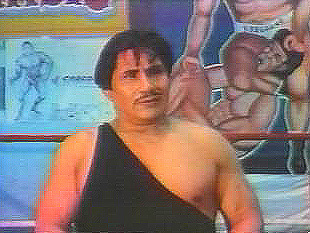
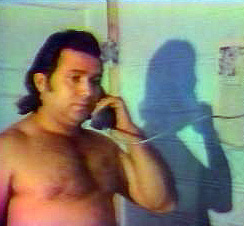
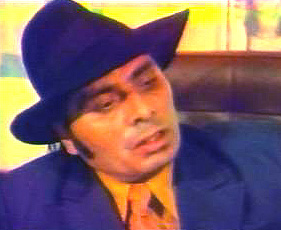
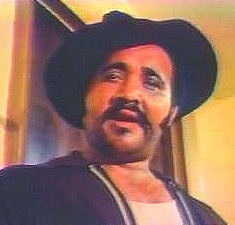
An opening scene at the
"Arena Valentino"--in which wrestler El Asesino mortally injures
his opponent--is followed by a cheesecake sequence showing police agent
Camelia exercising and showering in her apartment. Camelia is summoned to the office of
Arturo Vargas, who assigns her to help investigate a drug smuggling
ring. Pro wrestlers-crimefighters
El Soberano and the "Hermanos Rojo" (El Valentino and Félix
Ramírez) will be working with them. El Soberano, in his gym in Peru, receives a telegram and calls El
Valentino and Ramírez in Puerto Rico to plan their trip.
Meanwhile, the sinister Dr.
Gandía assembles his gang of evil wrestlers--including El Asesino, El
Araña, El Yancy (who wears a yellow mask), and La Bruja Maldita--to warn
them about the imminent arrival of Soberano and the Hermanos Rojo (who
sometimes wear matching red sports jackets). The heroic grapplers must not be allowed
to meddle in Gandía's "business," so when Vargas and Camelia
greet El Soberano, El Valentino, and Ramírez at Kennedy Airport, they are
waylaid by the villains. After a
lackluster battle in the parking lot (witnessed at close range by some
curious bystanders), the scene comes to an abrupt end with no particular
resolution.
The rest of the movie is a
succession of clashes between Soberano and the Hermanos Rojo and Gandía's
henchmen. El Asesino murders Tony
Genao in the ring. El
Soberano--Camelia's boyfriend--is attacked on the street, El Valentino (in
his tighty-whitey underwear) is assaulted in his hotel room, one guy is
murdered in a gym by El Asesino with a barbell across his neck. Vargas poses as a reporter to attend a
party at Gandía's house, which erupts into a brawl between various drunken
wrestlers. Gandía himself has a
brief but mildly explicit softcore sex scene with his girlfriend. Gandía later murders his
"mole" in the police department: "Here's your pay! Ha ha ha
ha!!"



Irritated by the failure of his
men to dispatch Soberano and his pals, Gandía hires "El
Cumplidor" (director Torres wearing a black wig) to kidnap
Camelia. Despite the abduction of
his girlfriend, El Soberano has to wrestle for the "world
championship" against El Asesino. [A sign indicates this takes place on August 11, 1972, and pits the
"champion of Peru vs. the champion of New York."] El Soberano wins; El Asesino is killed
by a sniper's bullet intended for his opponent. El Valentino and Ramírez shoot the
assassin (El Araña) who tells them where to find Camelia before he
dies.
Soberano, the Hermanos Rojo and
the police raid Gandía's house and rescue Camelia. El Soberano catches Gandía in a field
but the evil mastermind nearly slays him with a knife before Vargas shoots
him to death. El Soberano: "This is the end of an empire of
drugs and crime." As the
movie concludes, El Valentino and Ramírez depart for Puerto Rico. El Soberano and his new wife Camelia
leave for their honeymoon in Peru.
Sangre en Nueva York is a fun film,
filled with bizarre characters (and hairstyles and clothes) who take their
roles very seriously. The stocky,
stern-faced El Soberano looks like a muscular Ernesto Gómez Cruz and is
clearly the protagonist, with El Valentino and Félix Ramírez in
support. Sandra Carlo, after her
initial cheesecake exercise-and-shower sequence (and two nightclub scenes,
one in which she dances and the other in which she sings), is cute but has
little to do. Johnny Chevere and
Héctor Alvarez are both OK, although Chevere has the flashier role. More amusing is director Torres as the
sinister El Cumplidor, who looks hilarious in his long, black wig.
The supporting wrestlers don't
have much to do--El Asesino and El Araña are the primary villains, and El
Yancy is notable chiefly because he's one of the few masked
wrestlers in the movie (unlike Mexican lucha libre pictures, which are
dominated by masked men). The only other wrestler whose name rings a bell
is Carlos (aka Carlitos) Colón, who later appeared in Santo en Oro Negro. There are four
or five ring sequences in the picture, none of particular interest or
drama.
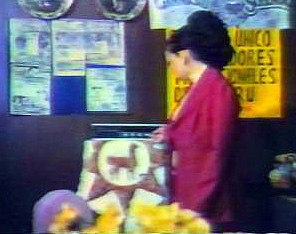

Surprisingly, the direction is
satisfactory, with a variety of camera angles, some nice kinetic cutting,
and relatively decent lighting and editing (although the print used for
the Miracle Pictures DVD is, as expected, deteriorated). The New York area location shooting adds
a few points of interest, including glimpses of the Metropole Cafe, the
Doll adult-movie theatre, and the Cine 1 and Cine 2 duplex, which is
showing double features of Duelo de
karate- Tápame contigo and
Los perros de Dios-La buscona. Although there is a long scene in the
"Gimnasio Soberano" which is supposedly in Peru, I wonder if it
was actually shot there (the following sequence in Soberano's office is
made "Peruvian" by the inclusion of a Peruvian flag and a pillow
with an embroidered llama on it). The same question arises about the "Puerto Rican" scene
with El Valentino and Félix Ramírez, which could have been filmed
anywhere.
A few additional notes:
(a) after El Asesino kills Tony Genao in the
ring, a large newspaper "EXTRA" is seen, with the headline
"Crimen en Lucha Libre" and the ubiquitious sub-head "Panic
in New York: Menagerie Breaks Loose" (visible in numerous other 1960s
and 1970s movies, including El Callao).
(b) a poster in Dr. Gandía's office advertises
a wrestling show on July 21 at "Junior High School #22." Be there!
(c) one trait Sangre en Nueva York shares with Mataron a Elena is the penchant for
using hand-lettered signs even for "official" purposes, such as
the door of a newspaper editor's office, a jail, etc. Honestly, these really look tacky
and add to the home-movie flavor of the proceedings.
Despite four different writing
credits, Sangre en Nueva York
does not have a particularly complex plot. Gandía's criminal "empire" is vaguely described at best,
and his henchmen are so inept that they never accomplish much. Gandía himself is petulant and arrogant
but doesn't seem to have any sort of master plan or even a specific
short-term goal, other than the elimination of Los Rojos. The "sniper tries to kill hero in
the ring, hits his opponent instead" was used several times in Santo
and other Mexican lucha films,
and the rest of the sketchy plot is also familiar stuff. The overall execution is crudely
amusing, although at 91 minutes this is a bit too
long.


Email me with comments: dwiltSPAM@umd.edu (remove NOSPAM)